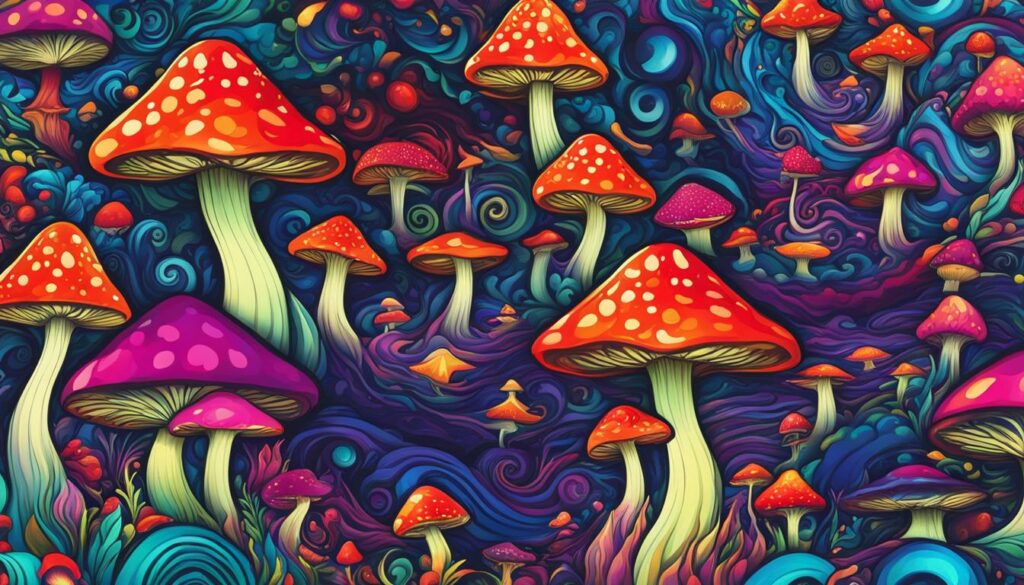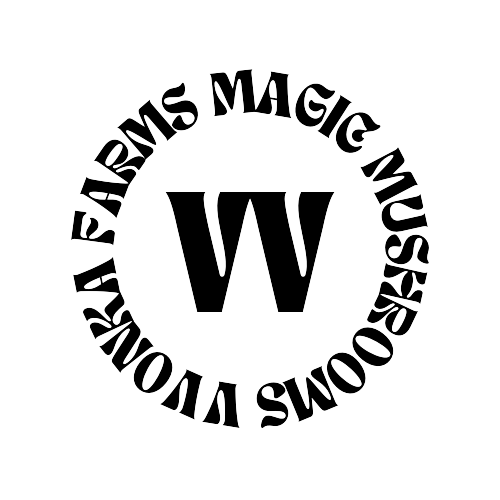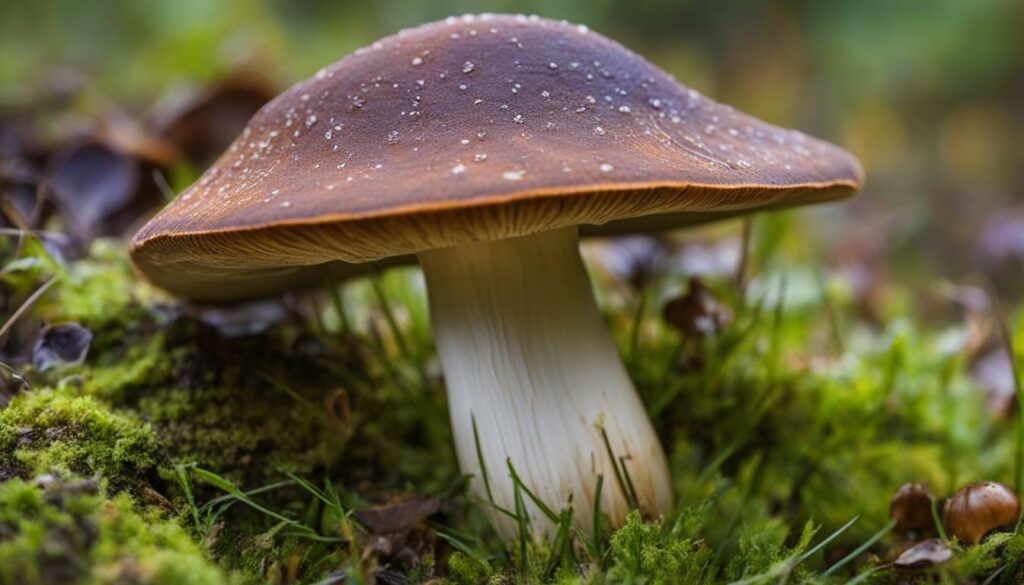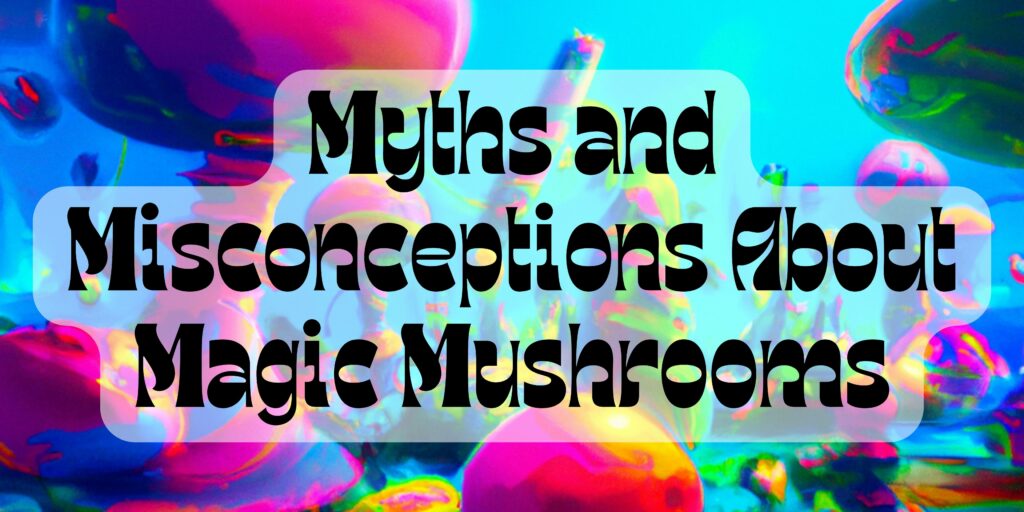Psilocybin mushrooms, also known as “magic” mushrooms, have gained popularity for their ability to induce colorful and visionary states of mind. But when it comes to consuming these mushrooms, it’s important to understand the right frequency for a safe and beneficial experience.
Research suggests that psilocybin therapy may have therapeutic benefits for conditions such as depression, anxiety, and addiction. However, it’s crucial to note that these studies have used controlled doses and closely monitored sessions. The frequency of shroom consumption should be guided by professional advice and individual needs for harm reduction.
Key Takeaways:
- Consult with a healthcare professional or trained psychedelic therapist for guidance on shroom consumption frequency.
- Start with a low to moderate dose and gradually increase if necessary, while allowing for sufficient integration and reflection time between trips.
- Engage in the process of integration after a shroom trip to reflect on and integrate the insights gained into daily life.
- Prioritize self-care, including getting enough rest, practicing mindfulness, and maintaining a healthy lifestyle.
- Stay informed about the latest research findings and consult with professionals for guidance on the frequency of shroom trips.
Understanding the Effects of Psychedelics
Psychedelics, including psilocybin mushrooms, are powerful psychoactive substances that can have profound effects on perception, mood, and cognition. These substances work by activating serotonin 5-hydroxytryptamine 2A receptors in the brain, leading to alterations in consciousness and a range of subjective experiences.
Recent research has shown promising results in the use of psilocybin-assisted therapy for conditions such as cancer-related distress, anxiety, and depression. Participants in these studies have reported significant reductions in symptoms and improvements in overall well-being. Additionally, psilocybin has shown potential in treating addiction, with some individuals experiencing prolonged abstinence from substances.
It’s important to note that the effects of psychedelics can vary widely depending on individual factors, such as dosage, set, and setting. The dosage of psilocybin mushrooms should be carefully considered, as higher doses may lead to more intense experiences. The setting in which the experience takes place is also crucial, as a safe and supportive environment can contribute to a positive trip.
Psychedelics can provide profound insights and experiences, but it is essential to approach them with respect and caution. The effects of these substances can be unpredictable, and they should only be used in a controlled and responsible manner.
Psilocybin Mushroom Usage Frequency
When it comes to the frequency of psilocybin mushroom use, there is no one-size-fits-all answer. Individuals should consider their personal needs, intentions, and individual circumstances. It’s always advisable to consult with a healthcare professional or a trained psychedelic therapist who can provide guidance tailored to your specific situation.
For therapeutic purposes, a structured treatment plan involving multiple sessions under professional supervision may be recommended. These sessions are typically spaced out over several weeks or months, allowing for integration and reflection between each experience. However, recreational use of psilocybin mushrooms may be less regimented, with individuals choosing to consume them on an occasional basis.
Ultimately, the frequency of psilocybin mushroom use should be guided by responsible and intentional use practices. It’s important to prioritize integration and self-care in between trips, as well as to create a safe and supportive environment for the psychedelic experience.
Factors to Consider for Safe Shroom Consumption
When it comes to consuming shrooms, there are several important factors to consider for a safe and enjoyable experience. The guidelines for using shrooms emphasize the need for professional advice, individual needs, and harm reduction. Consulting with a healthcare professional or a trained psychedelic therapist is crucial. They can provide personalized guidance on the optimal dosage and frequency of shroom trips based on your specific circumstances.
Creating the right setting for your shroom experience is also essential. A safe and comfortable environment can contribute to a positive trip. Find a quiet and peaceful space where you feel relaxed and secure. Consider factors such as lighting, temperature, and privacy. Creating a playlist of soothing and uplifting music can enhance your experience as well.
It is recommended to start with a low to moderate dose of shrooms, especially if you are a beginner or have limited experience with psychedelics. Gradually increasing the dosage as you become more comfortable and familiar with the effects can help you find your optimal dose. This approach allows for better integration and reflection time between trips.
| Guidelines for Safe Shroom Consumption | Recommendations |
|---|---|
| Consultation | Seek professional advice from a healthcare professional or trained psychedelic therapist. |
| Setting | Create a safe, comfortable environment for your shroom experience. |
| Dosage | Start with a low to moderate dose and gradually increase as needed. |
| Integration | Allow for sufficient time between trips for integration and reflection. |
Remember that everyone’s experience with shrooms is unique, and what works for one person may not work for another. It is important to listen to your own body and mind, and adjust the frequency of shroom consumption accordingly. Regular check-ins with professionals or support groups can also provide valuable insights and support on your journey with psychedelics.
The Importance of Integration and Self-Care
After a shroom trip, it is crucial to prioritize integration and self-care to enhance the overall psychedelic experience. Integration refers to the process of reflecting on and incorporating the insights and experiences gained during the trip into daily life. This phase allows individuals to make meaningful connections, integrate new perspectives, and deepen their understanding of themselves and the world around them.
Self-care plays a vital role in supporting integration and promoting overall well-being. Engaging in self-care practices such as journaling, therapy, meditation, or engaging in hobbies can help individuals process and make sense of the psychedelic experience. These practices provide a space for introspection, emotional processing, and personal growth.
“Integration is not just about what you do during the psychedelic experience, but also how you bring those insights and experiences back into your everyday life.”
When determining the frequency of shroom trips, it is important to consider an individual’s ability to effectively integrate and process the insights gained from each experience. Integration takes time, and rushing into consecutive trips without proper reflection and integration can limit the potential benefits of the psychedelic experience. It is recommended to allow for sufficient time between trips to fully integrate the lessons learned and to ensure emotional and mental well-being.
| Integration and Self-Care Strategies | Benefits |
|---|---|
| Journaling | Provides a space for self-reflection and tracking personal growth. |
| Therapy | Allows for deeper exploration of psychedelic experiences with the guidance of a trained professional. |
| Meditation | Enhances mindfulness and self-awareness, promoting a sense of inner peace and clarity. |
| Hobbies and Creative Expression | Facilitates emotional processing and provides an outlet for self-expression. |

Remember, the frequency of shroom trips should always be approached with caution and respect for individual needs. Consulting with a healthcare professional or trained psychedelic therapist is crucial in determining the appropriate frequency based on personal circumstances and goals. Prioritizing integration and self-care ensures a more meaningful and transformative psychedelic experience.
Understanding the Risks and Potential Side Effects
When it comes to the frequency of psychedelic mushroom use, it is important to be aware of the potential risks and side effects. While psilocybin mushrooms are generally considered safe, individual factors and dosage can influence the experience. Some common side effects include nausea, anxiety, and temporary changes in perception. It is crucial to approach the consumption of psychedelic mushrooms with caution and take precautionary measures to ensure a safe and positive experience.
“While psilocybin mushrooms have shown promise in therapeutic settings, it is important to remember that they are powerful substances that can have profound effects on the mind and body,” says Dr. Emily Carter, a psychedelic researcher. “It is essential to conduct thorough research, understand the potential risks, and practice harm reduction techniques when using psychedelics.”
By conducting thorough research, individuals can educate themselves about the potential risks and side effects associated with psychedelic mushroom use. This knowledge can help them make informed decisions about the frequency and dosage that is right for them. Additionally, creating a safe and supportive environment, incorporating integration practices, and prioritizing self-care are key factors in maximizing the benefits of psychedelic experiences. Regular check-ins with professionals or support groups can also provide valuable guidance and support throughout the journey.
| Side Effects | Risks |
|---|---|
| Nausea | Potential for triggering or exacerbating underlying mental health conditions |
| Anxiety | Potential for challenging or overwhelming experiences |
| Temporary changes in perception | Potential for adverse reactions when combined with certain medications or substances |
Understanding the risks and potential side effects of psychedelic mushroom use is essential for responsible and safe consumption. By approaching these substances with respect and knowledge, individuals can navigate their own unique journeys and explore the profound benefits that psilocybin mushrooms may offer.
Expert Insights and Future Research
Experts in the field of psychedelic research are continuously exploring the frequency of shroom consumption and its potential therapeutic benefits. Ongoing studies aim to understand the long-term effects, risks, and benefits of psychedelic substances, providing valuable insights for individuals interested in using shrooms.
Research is focused on various aspects, including:
- Optimal dosing schedules: Scientists are working to identify appropriate dosing schedules that maximize the therapeutic benefits of psilocybin mushrooms while minimizing potential risks and side effects.
- Mental health conditions: The impact of psychedelics on different mental health conditions, such as depression, anxiety, and PTSD, is being studied to determine their effectiveness as a treatment option.
- Integration practices: Integration, the process of incorporating psychedelic experiences into everyday life, is a crucial aspect of safe and beneficial use. Researchers are exploring different integration practices, such as therapy and mindfulness, to enhance the long-term benefits of shroom trips.
“Ongoing research in psychedelics is essential to expand our understanding of their potential benefits and risks. It’s an exciting time for the field, as we uncover new insights that can contribute to improved therapeutic applications.” – Dr. Sarah Johnson, Psychedelic Researcher
As the field of psychedelic research continues to evolve, staying informed about the latest findings and consulting with professionals is highly recommended. Psychedelic therapy holds great promise, but it should always be approached with caution and respect for individual needs and circumstances. Future research will provide further guidance on the frequency of shroom trips and best practices for safe and effective consumption.

Conclusion
The frequency of shroom consumption should be approached with caution and guided by individual needs, professional advice, and responsible use practices. Research suggests that psilocybin therapy can provide therapeutic benefits for conditions such as depression, anxiety, and addiction. However, it is essential to prioritize integration and self-care in between trips, as well as create a safe and supportive environment for the psychedelic experience.
As the field of psychedelic research continues to evolve, more insights and guidelines may emerge to help individuals navigate the frequency of shroom consumption for optimal results. It is important to stay informed about the latest research findings and consult with professionals for guidance on the frequency of shroom trips. By following recommended dosing schedules, practicing harm reduction techniques, and maintaining an integration and self-care routine, individuals can maximize the potential benefits of psychedelic mushroom use while minimizing potential risks.
Remember, the goal is to create a balanced and mindful approach to shroom consumption. By considering personal needs, seeking professional guidance, and engaging in self-care practices, individuals can create a shroom consumption schedule that respects both the power of these substances and their own mental and physical well-being.
FAQ
How often should I do shrooms?
The frequency of shroom consumption should be guided by professional advice and individual needs for harm reduction.
What are the therapeutic benefits of psilocybin therapy?
Psilocybin therapy has shown positive results in reducing depressive symptoms and anxiety, with some participants experiencing complete remission. It has also shown promise in treating addiction.
What factors should I consider for safe shroom consumption?
It is crucial to consult with a healthcare professional or trained psychedelic therapist for guidance on dosage and frequency. The setting in which the experience takes place is also important.
How should I integrate my shroom experiences into daily life?
Integration can be achieved through journaling, therapy, meditation, or other self-care practices. The frequency of shroom trips should be determined by the individual’s ability to integrate and process the insights gained from each experience.
What are the risks and potential side effects of shroom consumption?
Common side effects include nausea, anxiety, and temporary changes in perception. It is important to practice harm reduction techniques and prioritize responsible use.
What are the expert insights and future research on shroom consumption frequency?
Experts in the field of psychedelic research are continuing to explore the optimal frequency for shroom consumption and its potential therapeutic benefits. Ongoing research aims to understand the long-term effects, risks, and benefits of psychedelic substances.
What is the recommended shroom consumption schedule?
The frequency of shroom consumption should be approached with caution and guided by individual needs, professional advice, and responsible use practices.




